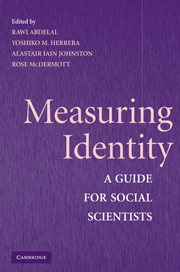Book contents
- Frontmatter
- Contents
- Contributors
- Introduction
- I DEFINITION, CONCEPTUALIZATION, AND MEASUREMENT ALTERNATIVES
- II SURVEY METHODS
- III CONTENT ANALYSIS AND COGNITIVE MAPPING
- 7 Quantitative Content Analysis and the Measurement of Collective Identity
- 8 The Content and Intersection of Identity in Iraq
- 9 A Constructivist Dataset on Ethnicity and Institutions
- IV DISCOURSE ANALYSIS AND ETHNOGRAPHY
- V EXPERIMENTS
- Bibliography
- Index
7 - Quantitative Content Analysis and the Measurement of Collective Identity
Published online by Cambridge University Press: 05 June 2012
- Frontmatter
- Contents
- Contributors
- Introduction
- I DEFINITION, CONCEPTUALIZATION, AND MEASUREMENT ALTERNATIVES
- II SURVEY METHODS
- III CONTENT ANALYSIS AND COGNITIVE MAPPING
- 7 Quantitative Content Analysis and the Measurement of Collective Identity
- 8 The Content and Intersection of Identity in Iraq
- 9 A Constructivist Dataset on Ethnicity and Institutions
- IV DISCOURSE ANALYSIS AND ETHNOGRAPHY
- V EXPERIMENTS
- Bibliography
- Index
Summary
CONTENT ANALYSIS INTRODUCED
Content analysis, simply put, is the quantitative investigation of message characteristics. Most definitions are a bit more specific than this, often delineated by the degree to which a scientific method is assumed. The following definition is employed here:
Content analysis is a summarizing, quantitative analysis of messages that relies on the scientific method (including attention to objectivity-intersubjectivity, a priori design, reliability, validity, generalizability, replicability, and hypothesis testing) and is not limited as to the types of variables that may be measured or the context in which the messages are created or presented.
(Neuendorf 2002: 10)In content analysis, as in all quantitative investigations, the quality of a measure is dependent on several factors. First, there must be a clear conceptualization of the construct of interest, for it is the congruence between conceptualization and operationalization (measurement) that constitutes basic internal validity (Babbie 1998).
First, We Conceptualize
With the construct of collective identity, conceptualization can be problematic, in that theoretic approaches abound. Abdelal et al. (2006: 695) refer to the “definitional anarchy” of identity research and, as Bruland and Horowitz (2003: 1) note, “the existence of identity as a universal but largely implicit concept makes it difficult to isolate and understand its use.”
- Type
- Chapter
- Information
- Measuring IdentityA Guide for Social Scientists, pp. 203 - 236Publisher: Cambridge University PressPrint publication year: 2009
- 13
- Cited by



